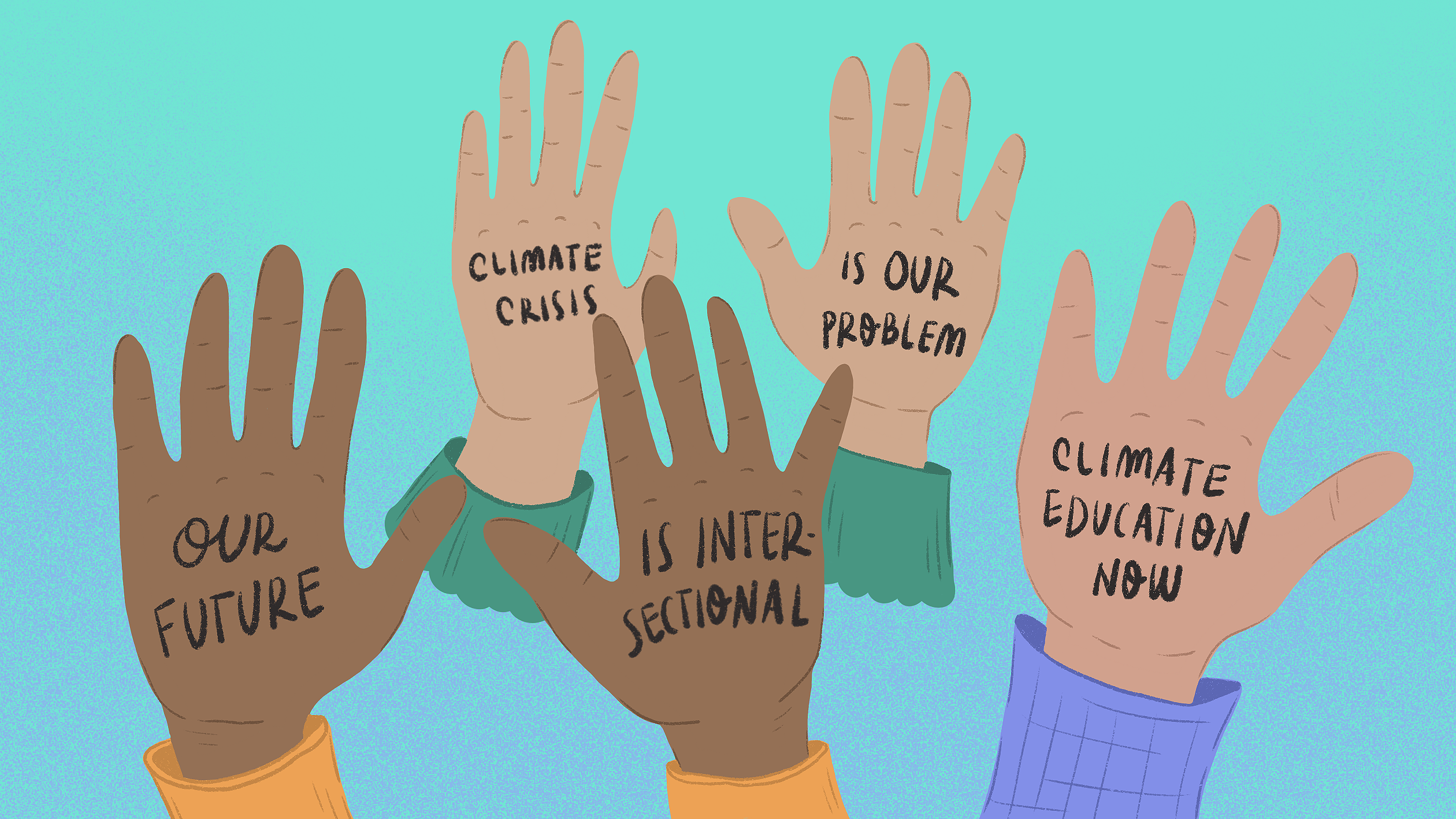
Illustration by Daniela Nunes
Release the power of all: climate action together
by Elif Bayat
In recent years, young people’s interest in tackling the climate crisis has become increasingly evident, especially since the proliferation of the Fridays for Future protests in Europe. While arguably being a characteristic and generation-defining movement, it is far from all-encompassing. Interestingly, young people from disenfranchised subgroups are way less engaged with the movement. This is even more worrisome, as these marginalised groups are the ones who are at a higher risk of suffering severely from the effects of the climate crises. The severe impact that the climate crises might bring for these youth also serves as a vector for raising awareness. As daunting as this challenge may seem for a volunteer or youth worker, it is not only feasible but also a stringent requirement, as we need society at large to combat the worst effects of the climate crisis.
 A personal path to climate engagement
A personal path to climate engagement
I was born, the child of Turkish immigrants, and raised in Germany. For me, Germany is not only my predominant place of residence but first and foremost my home country. Concerning the future of Germany in particular, I categorise myself as a stakeholder to no lesser degree than someone whose family has lived in Germany for centuries. Thus, in my opinion, my ongoing commitment to environmental protection is nothing less than the pursuit of welfare, prosperity and happiness for our society at large. Emphasising a balance of concern for the broader society, while still not negating one’s individual benefit in combating climate change, seems like an effective communication tool for me.
I have been actively involved in the climate and environmental movement for seven years now. What once started as a brazen decision when I adopted the vegan lifestyle at just 16 years old has evolved into a profound change in my life. My involvement has only expanded over time, from local activities to nationwide efforts, up to international levels. However, I need to remember that my involvement was not a foregone conclusion. In my local, working class and immigrant-based community, participation in environmental and climate protection remains limited, and there is a persisting lack of appropriate access and interest.
Anecdotally, when I asked those young friends and family of mine, what their opinions regarding climate change are, I was not met with scepticism or their like, but I most often just received the answer that there were more pressing issues at the moment. Often, they were struggling with financial and personal issues, which required urgent relief and action. Climate change, and its potential to cause severe damage, seemingly existed as one of the last items on the mental to-do list of those people.
 Seeing climate action as a possible chance to address other issues as well
Seeing climate action as a possible chance to address other issues as well
The changing climate impinges upon all spheres of life, be it the economic, public health, educational realm and so forth. It is neither an isolated problem nor is there a single solution. Quite the contrary is true: combating and mitigating the worst effects of climate change will not only need the joint effort of the private and public sectors but also the backing of as many individual members of society.
How should we approach young, often disenfranchised people, living in a post-migrant society, to not only make them aware but ideally enthuse them to actively participate?
As I stressed above, the contemporary youth in our post-migrant society is often preoccupied with more, in their eyes, time-sensitive concerns but also influenced by a youth culture that often focuses on such notions as individualism and short-term material prosperity – to the detriment of long-term personal and political development. Climate advocacy and action, with its less immediately tangible benefits, is thus often relegated to the backstage, especially when contrasted to more well-off and privileged adolescents, who place a comparatively way larger importance on this subject.
Thus, when advocating for climate activism, one should adopt a holistic approach, incorporating the tangible, short-term benefits one policy might provide for the individual and their surroundings, in addition to the long-term benefit of a less disruptive climate change.
For example, the lack of public transport and our over-reliance on cars is not only an environmental problem but also inhibits poor people in their ability to engage in the economy. Improving public transport thus might not only be beneficial for the environment but also increase personal, and even our general, prosperity. A win-win-win. And, as I pointed out above, better-off people are more likely to care about the climate crises in the first place – ideally creating a positive feedback loop.
 Why do we always have to talk about the climate from an intersectional perspective?
Why do we always have to talk about the climate from an intersectional perspective?
While everyone will be affected, the severity will be disproportionately felt by marginalised groups. Both in Europe and abroad. This inequality is linked to deeply ingrained socio-economic factors, housing conditions, health vulnerabilities, discrimination, and a lack of political representation. This is where intersectionality becomes a central issue. Only by seeing, hearing, and most importantly, acknowledging and addressing the manifold problems these people are subjected to, can we hope to build a broad and strong coalition against climate change.
 But what can be done to bring marginalised people into the fold?
But what can be done to bring marginalised people into the fold?
Communication should be aimed at disposing of the misunderstanding that the climate crisis might be a “them-problem” and instead imparting the notion, that it is an “our-problem”, without conveying a sense of doom but stressing the efficacy of the individual instead. At the same time, policies should not only be designed with the needs of a diverse society in mind but also communicated holistically. Addressing tangible, contemporary grievances should be part of climate policy whenever possible. To accomplish this, which is by no means an easy balancing act, here is a non-exhaustive assortment of ideas of mine:
 Personal engagement and encouragement
Personal engagement and encouragement
The first, and at the same time easiest, step is to address each person as an individual with unique interests, beliefs and struggles. For some, the starting point might be animal welfare, a local nature reserve, or the struggle with rising energy costs. A targeted approach here can lay the groundwork and can act as the foundation used to widen the subject’s horizon. In my case, the seed, which started it all, was animal welfare. This was the slippery slope that encouraged me to attend workshops, meetings and similar events, which eventually led me to see the broader picture.
 Safer spaces
Safer spaces
For me, a safer space is somewhere I receive acceptance without having to justify myself for my innate personal characteristics. Many marginalised groups are in a chronic mindset of defence, as they are afraid of discrimination and resentment. This leads to, among other things, constant wariness, and an unwillingness to openly voice their opinion. Safer spaces offer rare, non-judgmental environments from discrimination and encourage exchange among like-minded people. Safer spaces thus enable marginalised groups to form their perspectives with their unique backgrounds and perspectives in mind.
 Coalition building through allyship
Coalition building through allyship
In these exchange spaces, the focus is on intersectional perspectives that integrate different realities of life. But as important as self-empowerment is for the individual to attain the right mindset in the first place, our ultimate goal should not be segregation but coalition building. Allyship thus refers to the solidarity of a privileged person with people who are disadvantaged in society. It is an ongoing learning process aimed at showing solidarity and overcoming power imbalances. It is important that educational work is accessible to all and accepts the diversity and validity of different lifestyles. I can vouch for the fact that it is a surprising but extremely nice feeling to be offered solidarity and acceptance for a change, from persons and institutions, which usually grant you the opposite.
 Creating role models
Creating role models
What happens when your favourite rapper suddenly starts rapping about issues like plastic pollution and recycling? Or when the popular TikToker calls for direct action? Perhaps this sounds strange at first, but why should it not happen? A single move by a single personality like that can change more minds and hearts in specific subgroups than any head of state could hope to do with a dozen enthusiastic speeches. This vector of attack is certainly significant, but beyond that, it is primarily friends and acquaintances who serve as role models. They self-evidently know best how to target and convince a specific individual. If they are open with their convictions and do not shy away from displaying them, the impact on people, who are otherwise hard to reach, cannot be overstated.
 Climate change education
Climate change education
An important point that I have never personally experienced, but which now seems to me to be of great utility, was also emphasised in the Communiqué of the official youth participation group of the G20 countries this year. It is about introducing climate education in schools, a step that can make climate knowledge more accessible, not only for those who already have a preconceived interest in the topic but for everyone. Although many countries have already implemented some changes in this direction, there is still much to be done.
 Conclusion
Conclusion
The climate problem is the everything problem. Even so, while its effect is disproportionately felt by marginalised groups, conversely these groups seem to be disproportionately underrepresented in the coalition to fend off its worse effects. To understand this seeming paradox, it is important to be aware of its roots and thus, hopefully, it can be remedied to such an extent that meaningful but still acceptable legislation can be introduced to adequately address the complex issues at hand. The importance of intersectional and non-judgmental thinking, in the context of climate protection, cannot be overemphasised. Integrating diverse voices, sharing best practices and adopting an intersectional perspective can pave the way for a more inclusive and equitable climate movement. One which is not blind to the everyday struggle of disenfranchised groups. One which has this struggle in mind, when advocating for climate action.
 Resources for further exploration
Resources for further exploration
For more inspiration on methods in the field of sustainability for youth workers and educators, T-Kit-13 of the Youth Partnership of the European Union and the Council of Europe is a useful resource: https://pjp-eu.coe.int/en/web/youth-partnership/t-kit-13-sustainability-and-youth-work
For all who are interested in scientific facts in the context of Youth Research and Development, the study “Disobedient youth: lessons from the youth climate strike movement” (2021) is recommended: https://pjp-eu.coe.int/documents/42128013/47261800/Gorman-J.-%282021%29-Disobedient-Youth-Lessons-from-the-Climate-Strikes.pdf/b1ec729d-ee2f-1e5d-9de3-a22b68e61bb8
 References
References
Y20 Communiqué 2023 (G20 Youth Summit Communiqué): https://y20india.in/wp-content/uploads/2023/08/Y20_Communique-digital-web.pdf

Elif is a student of social sciences with a passion for democracy, social equality and the participation of young people in political and social decision-making processes.


